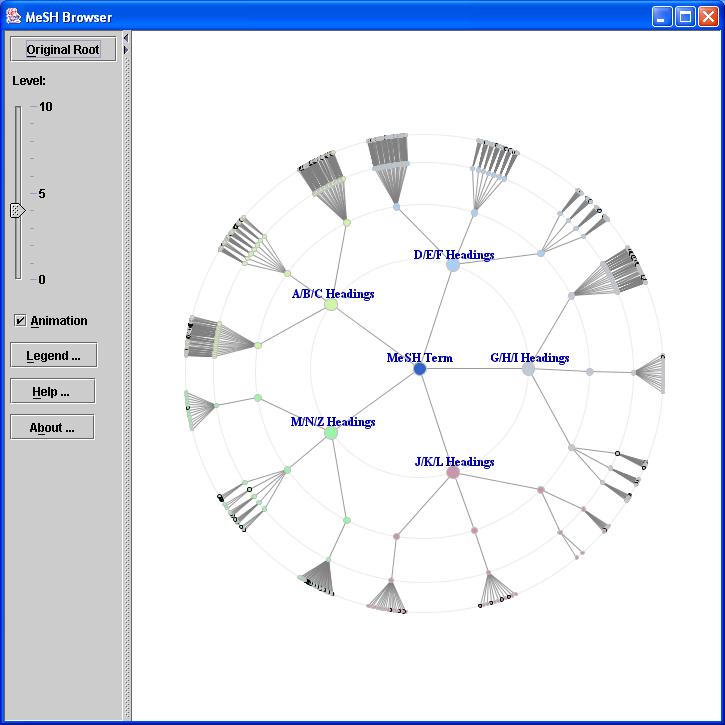Software > Radial Trees
Description | Pros and Cons | Applications | Details | Usage Hints | References | Acknowledgments
| Description |
Radial tree layout uses focus + context (fisheye) technique for visualizing and manipulating large hierarchies. In a radial tree, the focused node is placed in the center of the display and all other nodes are rendered on appropriate circular levels around that selected node. The further away a node is from the center, the smaller it is rendered. This way, very large hierarchies can be displayed.
| Pros & Cons |
Many hierarchies, such as controlled vocabularies or file directory structures, are too large to display in their entirety on a computer screen. Radial trees display potentially very large rooted or unrooted trees. Users can focus on particular parts of those trees without losing context. Crossing of edges during the animated focus change appears to be confusing for users. User studies are needed to (dis)confirm this.
| Applications |
The Radial Tree package is available as part of the XML toolkit. Source folder contains DemoFile.java and DemoXML.java.
- DemoFile.java takes directory name as argument and visualizes its directory structure in Radial Tree layout. (image)
- DemoXML.java takes XML data file name as argument and visualizes hierarchical data set in Radial Tree layout. Tree.xsd is XML schema for sample XML file, MeSH.xml. (image)
| Details |
A radial tree layout places the selected/focus node in the center of the display. All other nodes arranged in concentric rings around the focus node. Each node lies on the ring corresponding to its level in the hierarchy from the focus node. Immediate children of the focus node lie on the smallest inner ring, their children lie on the second smallest ring, and so on. The angular width of a node’s subtree is simply the number
of leaf nodes among its descendants. Details are given here.
| Usage Hints |
Start the XML toolkit, load a tree data set, and select 'Radial Tree' to display it.
| References |
- G. Book and N. Keshary. (2001) Radial Tree graph drawing algorithm for representing large hierarchies. University of Connecticut.
- K Yee, D. Fisher, R. Dhamija, and M. Hearst. (2001) Animated exploration of dynamic graphs with radial layout. IEEE Symposium on Information Visualization, October 2001 .
- N. Sheth and Q. Cai. Visualizing MeSH dataset using Radial Tree Layout. Spring 2003 Information Visualization class project. (pdf) (demo)
| Acknowledgments |
This Radial Tree package was developed as a final project of Information Visualization class, Spring 2003, SLIS, IUB by Nihar Sheth (nisheth@indiana.edu) and Qin Cai. Basic framework of the package was developed by Jason Baumgartner. Demo of that project is available here.
![]()
Information
Visualization Cyberinfrastructure @ SLIS,
Indiana University
Last Modified January
14, 2004
